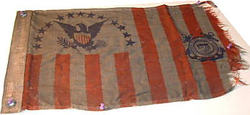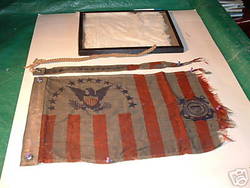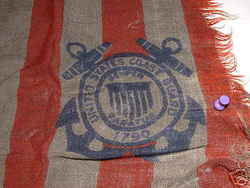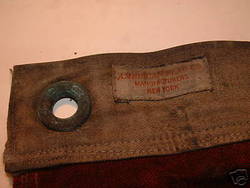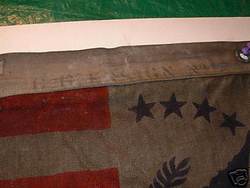United States // Coast Guard Ensign / 1915 - 1953
The Act of March 2, 1799, known as the Customs Administration Act authorized that "the cutters and boats employed in the service of the revenue shall be distinguished from other vessels by "an ensign and pendant, with such marks thereon as shall be prescribed and directed by the President of the United States."
The job of designing the distinguishing ensign eventually fell upon Oliver Wolcott, who had replaced Alexander Hamilton as Secretary of the Treasury in 1795. On June 1, 1799, Wolcott submitted his design to President John Adams for approval. Wolcotts proposal featured an ensign of sixteen vertical stripes, alternating red and white, representing the number of states that had joined the Union by 1799. In suggesting a correspondence of stripes and states, Wolcott was following the lead of Congress, which in 1794 had changed the national flag to fifteen stars and fifteen stripes, implying an adjustment at the entry of each new state. Wolcott, therefore, raised the number of stripes to sixteen, and dramatically turned their arrangement ninety degrees to differentiate the new revenue cutter ensign from the U.S. Flag.
This ensign was ultimately authorized August 1, 1799, when Secretary of the Treasury, Oliver Wolcott, issued an order announcing that in pursuance of authority from the President, the distinguishing ensign and pennant would consist of, "16 perpendicular stripes, alternate red and white, the union of the ensign to be the arms of the United States in a dark blue on a white field."
With a design in hand, each collector contracted with local flagmakers to furnish the new revenue cutter ensigns. Although originally intended as a marine ensign to be flown from revenue cutters and customs vessels, the collectors soon were flying it over their customhouses.
During the American Civil war the US Treasury Department began to issue standardized ensigns to the Revenue Marine and in 1874, Treasury Secretary William A. Richardson, required that during business hours, the customs ensign was to be hoisted by the side of the Stars and Stripes over all customhouses. A long standing practice that was now mandated. The same flag would be used on Customhouses as was used on vessels of the Revenue Marine until 1910.
It was then President Taft directed that the flag used by the Revenue Cutter Service be distinguished from that flown ashore by the addition of the RCS badge on the fly. In 1915, the U.S. Coast Guard was established as a bureau separate from the Bureau of Customs, inheriting the RCS ensign, while that without the badge was retained by what is now the U.S. Customs Service.
The badge of the United States Coast Guard was executed in blue in the fly and consisted of two crossed anchors over which was placed a disc bearing the shield of the US, with the service motto Simper Paratus above and below the shield. This was in turn surrounded by the words United States Coast Guard.
This ensign is typical of those used from 1915 to 1953.
Companion to ZFC3084
ZFC Important Flag
